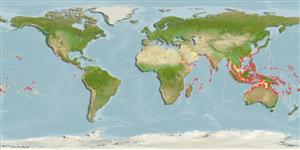Teleostei (teleosts) >
Anguilliformes (Eels and morays) >
Muraenidae (Moray eels) > Muraeninae
Etymology: Echidna: Greek, echidna = viper, 1847 (Ref. 45335).
Eponymy: In Greek mythology Echidna was a female monster, and mother of many other monsters including the Hydra. Hesiod described her as “half a nymph with glancing eyes and fair cheeks, and half again a huge snake, great and awful, with speckled skin.” (Ref. 128868), visit book page.
Environment: milieu / climate zone / depth range / distribution range
Ecology
Marine; reef-associated; depth range 0 - 48 m (Ref. 58302), usually ? - 10 m (Ref. 30404). Tropical; 32°N - 33°S, 27°E - 76°W
Indo-Pacific: Red Sea and East Africa (Ref. 33390) and Persian Gulf (Ref. 68964) to the Society Islands, north to southern Japan and the Hawaiian Islands, south to Lord Howe Island; throughout Micronesia. Eastern Central Pacific: southern Baja California, Mexico and from Costa Rica to northern Colombia (Ref. 9324). Also found in Southeast Atlantic.
Size / Weight / Age
Maturity: Lm ? range ? - ? cm
Max length : 100.0 cm TL male/unsexed; (Ref. 48635); common length : 50.0 cm TL male/unsexed; (Ref. 3258)
Found between rocks and corals of intertidal reef flats, also in shallow lagoon and seaward reefs to depths of at least 10 m (Ref. 9710, 58302). Benthic (Ref. 58302). Nocturnal (Ref. 68964). Feed mainly on crustaceans. Protogynous hermaphroditism unconfirmed for this species (Ref. 84746). Safely kept with small aquarium fishes (Ref. 9710). Solitary, seen usually in the open or with only head exposed (Ref 90102). Minimum depth reported taken from Ref. 86942.
Life cycle and mating behavior
Maturity | Reproduction | Spawning | Eggs | Fecundity | Larvae
Protogyny unconfirmed (Ref. 84746).
Chen, H.-M., K.-T. Shao and C.T. Chen, 1994. A review of the muraenid eels (Family Muraenidae) from Taiwan with descriptions of twelve new records. Zool. Stud. 33(1):44-64. (Ref. 6934)
IUCN Red List Status (Ref. 130435: Version 2024-1)
Threat to humans
Harmless
Human uses
Fisheries: minor commercial; aquarium: commercial
Tools
Special reports
Download XML
Internet sources
Estimates based on models
Preferred temperature (Ref.
123201): 24.9 - 29.3, mean 28.4 °C (based on 3674 cells).
Phylogenetic diversity index (Ref.
82804): PD
50 = 0.5005 [Uniqueness, from 0.5 = low to 2.0 = high].
Bayesian length-weight: a=0.00034 (0.00022 - 0.00052), b=3.32 (3.20 - 3.44), in cm total length, based on LWR estimates for this species & (Sub)family-body (Ref.
93245).
Trophic level (Ref.
69278): 4.2 ±0.71 se; based on food items.
Resilience (Ref.
120179): Low, minimum population doubling time 4.5 - 14 years (Preliminary K or Fecundity.).
Fishing Vulnerability (Ref.
59153): High vulnerability (60 of 100).
Nutrients (Ref.
124155): Calcium = 27.5 [14.8, 48.7] mg/100g; Iron = 0.421 [0.252, 0.924] mg/100g; Protein = 18.8 [16.5, 21.4] %; Omega3 = 0.102 [0.046, 0.288] g/100g; Selenium = 45.1 [24.8, 87.6] μg/100g; VitaminA = 58.5 [17.3, 181.5] μg/100g; Zinc = 0.886 [0.630, 1.224] mg/100g (wet weight);
